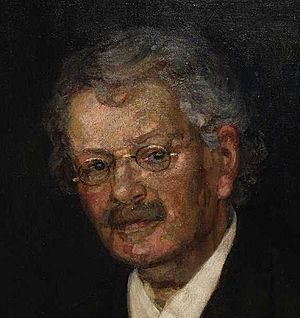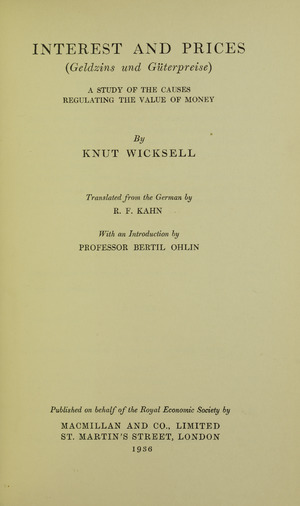Knut Wicksell facts for kids
Quick facts for kids
Knut Wicksell
|
|
|---|---|
 |
|
| Born |
Johan Gustaf Knut Wicksell
December 20, 1851 Stockholm, Sweden
|
| Died | May 3, 1926 (aged 74) Stocksund, Sweden
|
| Spouse(s) | Anna Bugge |
| Field | Political economics |
| School or tradition |
Stockholm School |
| Influences | Léon Walras, Eugen von Böhm-Bawerk, David Ricardo |
Johan Gustaf Knut Wicksell (born December 20, 1851 – died May 3, 1926) was an important Swedish economist. He was part of the Stockholm School of economics. His ideas greatly influenced two major economic ways of thinking: Keynesian and Austrian economics. He was married to Anna Bugge, a well-known supporter of women's rights.
Contents
Early Life and Education
Knut Wicksell was born in Stockholm, Sweden, on December 20, 1851. His father was a successful businessman. Knut lost both his parents when he was young. His mother passed away when he was only six years old. His father died when Knut was fifteen.
His father left him a lot of money. This allowed Knut to attend the University of Uppsala in 1869. He first studied mathematics and physics. He earned his first degree in just two years. He continued his studies and received his doctorate in mathematics in 1885.
In 1887, Wicksell received a scholarship. This allowed him to study in Europe. He attended lectures by the famous economist Carl Menger in Vienna. Over the next few years, Wicksell became more interested in social sciences, especially economics.
Becoming an Economist
Wicksell started teaching at Uppsala University. He became known for his strong opinions about labor. His early ideas caught some attention. However, his first economics book, Value, Capital and Rent (1892), was not widely noticed.
In 1896, he published Studies in the Theory of Public Finance. In this book, he used the idea of marginalism to discuss progressive taxation. He also wrote about public goods and other government policies. This book gained much more interest.
Wicksell married Anna Bugge in 1887. At that time, economics in Sweden was taught as part of law school. Wicksell needed a law degree to become a professor. So, he went back to the University of Uppsala. He finished a four-year law degree in only two years. In 1899, he became an associate professor there. The next year, he became a full professor at Lund University. This is where he did his most important work.
In 1916, Wicksell retired from Lund University. He then moved to Stockholm. There, he advised the government on money and banking issues. In Stockholm, Wicksell worked with other great economists. These included Bertil Ohlin, Gunnar Myrdal, and Erik Lindahl. They were all part of the "Stockholm School" of economics. He also taught a young Dag Hammarskjöld. Dag later became the Secretary-General of the United Nations.
Wicksell passed away in 1926. He was working on a final book about the theory of interest at the time.
Wicksell's Key Ideas
Influences on His Work
Knut Wicksell admired the ideas of several economists. These included Léon Walras (from the Lausanne school), Eugen von Böhm-Bawerk (from the Austrian school), and David Ricardo. Wicksell wanted to combine their different ideas into one overall economic theory. Because of this, he was known as an "economist's economist."
For example, the marginal productivity theory was developed by others. This theory says that payments to workers and resources match their extra output. But Wicksell showed this idea in a much clearer way. Many of our current ideas about this theory come from Wicksell's work.
Wicksell also studied how wealth is shared. He built on Ricardo's ideas. Wicksell believed that even a completely free economy would not make wealth equal for everyone. Instead, he thought that wealth created by growth would mostly go to those who already had wealth. Because of this, Wicksell supported the idea of government involvement. He believed it could help improve the well-being of the country.
Wicksell also influenced the field of constitutional political economy. In his 1896 book, Finanztheoretische Untersuchungen, he highlighted the importance of rules. These are the rules that politicians follow when making choices. He believed that to make things better, we should change the rules for making decisions. We should not just try to change how politicians act.
Interest and Prices
Wicksell's most important idea was his theory of interest. He first published it in German in 1898. The English version, Interest and Prices, came out in 1936.
Wicksell created the important term natural rate of interest. He defined it as the interest rate that keeps prices stable. If the interest rate is lower than this natural rate, prices will likely go up (inflation). If the interest rate is higher, prices will tend to fall (deflation). When the interest rate matches the natural rate, the market for goods is balanced. This leads to stable prices.
The Austrian School of economics used and expanded this theory. They believed that an economic boom happens when the actual interest rate falls below the "natural" rate. This can happen because of increases in the money supply.
The Cumulative Process
Wicksell's idea of the "cumulative process" is also very important. It suggests that if the natural rate of interest is not equal to the interest rate on loans, then people will want to invest different amounts than they save.
If the interest rate is below the natural rate, the economy grows. Prices will then rise, assuming all other things stay the same. This was an early idea of endogenous money. This means money that is created by the economy's own workings. It is not created by outside factors. Many theories of endogenous money have developed since Wicksell's time.
Wicksell's "cumulative process" theory of inflation was a big step. It challenged the idea that money is just a "veil." The Quantity Theory of Money suggests that more money leads to higher prices. Wicksell agreed, but he said the original increase in money comes from inside the economy. It is created by the relationship between the financial and real parts of the economy.
Wicksell argued that with credit money, there are two interest rates. One is the "natural" rate, which is the real profit rate on capital. The other is the "money" rate, which is the loan rate from banks. Banks create credit by making deposits that borrowers can use. Since these deposits are part of the money supply, banks can, in a way, "create" money.
Quantity Theory of Money
Wicksell's main point was that real changes in the economy can lead to an increase in the demand for money. At the same time, banks try to meet this demand by increasing the money supply.
If there is full employment and a stable way of making payments, then more money (M) in the equation MV = PY (Money x Velocity = Price x Output) leads only to higher prices (P). So, Wicksell kept the idea that in the long run, more money leads to inflation.
Wicksell showed that money is not just a "veil." People react to changes in money, and this is not because of some "money illusion." However, Wicksell still believed that in the long run, the Quantity Theory of Money holds true. This means money is still neutral in the long run. But to show this, Wicksell challenged some traditional economic ideas.
Wicksell's Legacy
The Swedish government adopted some of Wicksell's ideas. This included his rule for keeping prices stable in the 1930s. His vision for a welfare state also had a big impact.
Many economists believe Wicksell's contributions are very important to modern macroeconomics. Michael Woodford especially praised Wicksell. Wicksell suggested using the interest rate to keep prices stable. Woodford noted this was a remarkable idea when most money policies relied on the gold standard. Woodford even named his own textbook on money policy after Wicksell's work.
Economists Influenced by Wicksell
- James M. Buchanan
- Karl Gustav Cassel
- Friedrich Hayek
- Eli Heckscher
- Thomas M. Humphrey
- Katsuhito Iwai
- John Maynard Keynes
- Erik Lindahl
- Ludwig von Mises
- Gunnar Myrdal
- Edward J. Nell
- Bertil Ohlin
- Don Patinkin
- Dennis Robertson
- Michael Woodford
Schools of Thought Influenced by Wicksell
- Austrian School
- Keynesian
- Monetarism
- Neoclassical economics
- Neo-Keynesian economics
- Public choice theory
- Stockholm School
- New Classical economics
See also
 In Spanish: Knut Wicksell para niños
In Spanish: Knut Wicksell para niños
- Benefit principle
- Wicksell effect
- Wicksell's theory of capital
- Wicksellian Differential
Sources
- Boianovsky, Mauro; Erreygers, Guido (2005). "Social comptabilism and pure credit systems. Solvay and Wicksell on monetary reform", in : Fontaine, Philippe, Leonard, Robert, (ed.), The experiment in the history of economics, London, Routledge.
- Carlson, Benny; Jonung, Lars (September 2006). "Knut Wicksell, Gustav Cassel, Eli Heckscher, Bertil Ohlin and Gunnar Myrdal on the Role of the Economist in Public Debate"
- Jonung, Lars (1979). "Knut Wicksell's norm of price stabilization and Swedish monetary policy in the 1930s". Journal of Monetary Economics 5, pp. 45–46.
- Woodford, Michael (2003). Interest and Prices: Foundations of a Theory of Monetary Policy. Princeton University Press, ISBN: 0-691-01049-8.


